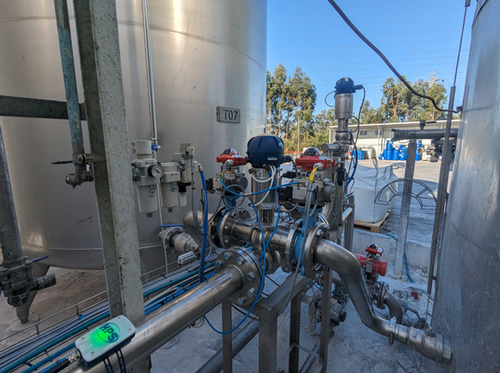THURSDAY, JANUARY 4, 2024
A recent case study conducted by Hygienic Pigging Systems Ltd. with Portuguese paint manufacturer Barbot Paints reportedly showed that the technology could reduce product contamination and product waste.
According to the news release, HPS Advanced Liquid Product Recovery Technology reduced contamination by 99.9% in the Portuguese paint manufacturing facility.
About the Research
Pigging is described as a specialist technology that works by introducing a projectile, called the pig, into the pipeline. A flexible, magnetized core in the pig can navigate sharp bends while still maintaining optimal product recovery rates.
Using a suitable medium to propel the pig, such as compressed air, carbon dioxide or water, the residual product is pushed to its destination.
Traditionally, HPS explains, pigging technology is used by manufacturers to recover residual products from pipelines, reducing waste and increasing yields.
Other benefits for liquid product manufacturers can include reduced production downtime and improved environmental sustainability.

 |
| HPS |
|
A recent case study conducted by Hygienic Pigging Systems Ltd. with Portuguese paint manufacturer Barbot Paints reportedly showed that the technology could reduce product contamination and product waste. |
Additionally, HPS explains, by recovering products from the lines with pigging technology, cleaning procedures are streamlined to reduce the risks of product contamination.
Barbot Paints reportedly discovered their need for pigging technology after discovering their bacterial contamination problem, as well as changing EU regulations regarding the use of biocides in paint production.
Due to the contamination, 20% of their product output was being recalled for rework, causing a significant amount of product and time loss.
Study Findings
The water-based paint contamination, Barbot found, was paint standing in the dedicated transfer pipes. The contaminated lines were being used to transport water-based resins, water-based calcium carbonate slurries, titanium dioxide slurries and water-based paints.
Barbot and HPS teams then identified four lines in need of pigging technology. HPS designed, supplied, implemented and commissioned four fully automatic, single-pig pigging systems for use in the factory, the companies say.
The lines transferred products between tanks, from raw materials to production to product holding. Two of the lines were 3-inches in diameter and two were 4-inches in diameter. All the lines varied in length.
The design of the HPS pig allows for bi-directional travel, HPS says, as well as a combination of propellants to be used. Barbot utilized water and compressed air to propel the pig through the line and back to its housing.
In addition to the systems, Barbot utilized the HPS AccuTect pig detection system, which can reliably track the location of the pig and control deployment and return from the HMI/PLC.
Since having the pigging systems commissioned, bacterial contamination in Barbot’s products has been reduced to almost zero, HPS explains.
By using water as a propellant, the initial flush that many manufacturers perform as part of their cleaning processes is incorporated into the pigging sequence. Pigging also reportedly recovered up to 99.5% of the residual product from Barbot’s lines, making CIP procedures more thorough.
Additionally, the water used by Barbot to propel the pig is collected upon return and recycled into production, cutting their water consumption and improving the company’s sustainability.
The presence of bacteria in the pipeline has been significantly reduced, the study writes, ensuring that Barbot’s products comply with quality and safety standards. They now now experience fewer product recalls, saving money and time on product rework and packaging disposal.
HPS notes that it has also previously worked with paint manufacturers such as PPG, AkzoNobel, Kelly-Moore Paints and Ronseal on a variety of projects.
Tagged categories: Case History; Cleanup; Coatings; Coatings manufacturers; Coatings Technology; Coatings technology; Coatings Technology; Contaminants; Good Technical Practice; Paint analysis; Pipes; Program/Project Management; Projects - Commercial; Quality control; Technology; Tools & Equipment - Commercial; Waterborne coatings